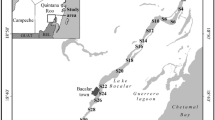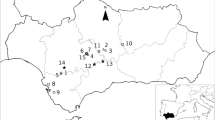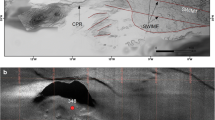Abstract
Profiles of oxygen and sulfide around the burrows of the lugworm, Arenicola marina, from a North Sea tidal flat were examined with microelectrodes, and the steep gradients were related to the microdistribution of nematodes. Around the tail shaft free oxygen penetrated only 2 mm into the burrow wall, coinciding with a bright zone sharply limited by the ambient black sediment. Contrastingly, in normal bottoms of the tidal flat (“controls”) only the surface of the bright zone was supplied with free oxygen. Here, the dark colouration coincided with the presence of free hydrogen sulfide. Around the tail shaft the nearest free hydrogen sulfide was detected 6 mm from the burrow wall leaving several millimetres of black sediment without measurable free sulfide. We discuss how these divergencies may relate to the stability of the oxygen/sulfide gradients and the course of time involved in their formation. A total of 54 nematode species were identified. Based on non-metric Multidimensional Scaling Ordination, four nematode assemblages corresponded to four microhabitats of the A. marina burrow: the funnel, the feeding pocket, the tail shaft and the feacal cast. The tail shaft assemblage (oxic plus partly anoxic zones) was similar to that of the anoxic zone of the control sediment. It was dominated by the most abundant nematode in the present study, Metalinhomoeus biformis (mean abundance in tail shaft 202 indx10 cm-3). Adults of common nematode species from sulfidic microhabitats had a significantly higher length/diameter ratio than those inhabiting the oxic zone of the control sediment (p<0.001). The chemical recordings and metric analysis indicate that these slender nematodes around the A. marina tail shaft and in the reduced horizons of the reference sites represent thiobiotic assemblages, as compared to the shorter and stouter oxybiotic species characterising the assemblages from the surface zone and (partly) the funnel.
Similar content being viewed by others
References
Aller JY, Aller RC (1986) Evidence for localized enhancement of biological activity associated with tube and burrow-structures in deep-sea sediments at the HEBBLE site. Deep-Sea Res 33: 755–790
Aller RC, Yingst JY (1978) Biogeochemistry of tube-dwellings: a study of the sedentary polychaete Amphitrite ornata (Leidy). Mar Res 36: 199–254
Anderson JG, Meadows PS (1978) Microenvironments in marine sediments. Proc R Soc Edinb (Sect B) 76B: 1–16
Baumfalk YA (1979) Heterogeneous grain size distribution in tidal flat sediment caused by bioturbation activity of Arenicola marina (Polychaeta). Neth J Sea Res 13: 428–440
Boaden PJS (1980) Meiofaunal thiobios and “the Arenicola negation”: case not proven. Mar Biol 58: 25–29
Boaden PJS, Platt HM (1971) Daily migration patterns in an intertidal meiobenthic community. Thalassia jugosl 7: 1–12
Booij K, Helder W, Sundby B (1991) Rapid redistribution of oxygen in a sandy sediment induced by changes in the flow velocity of the overlying water. Neth J Sea Res 28: 149–165
Boutilier RG, Heming TA, Iwama GK (1984) Appendix: physiochemical parameters for use in fish respiratory physiology. In: Gills W, Hoar S, Randall DJ (eds) Fish physiology, Academic Press, London, pp 403–430
Cadée GC (1976) Sediment reworking by Arenicola marina on tidal flats in the Dutch Wadden Sea. Neth J Sea Res 10: 440–460
Clarke KR (1993) Non-parametric multivariate analyses of changes in community structure. Aust J Ecol 18: 117–143
Dubilier N, Giere O, Grieshaber MK (1995) Morphological and ecophysiological adaptations of the marine oligochaete Tubificoides benedii to sulfidic sediments. Am Zool 35: 163–173
Fenchel TM, Riedl RJ (1970) The sulfide system: a new biotic community underneath the oxidized layer of marine sand bottoms. Mar Biol 7: 255–268
Giere O (1992) Benthic life in sulfidic zones of the sea — ecological and structural adaptations to a toxic environment. Verh dt zool Ges 85.2: 77–93
Giere O (1993) Meiobenthology. The microscopic fauna in aquatic sediments. Springer, Berlin
Giere O, Conway NM, Gastrock G, Schmidt C (1991) “Regulation” of gutless annelid ecology by endosymbiotic bacteria. Mar Ecol Prog Ser 68: 287–299
Giere O, Eleftheriou A, Murison DJ (1988) Abiotic factors. In: Higgins RP, Thiel H (eds) Introduction to the study of meiofauna. Smithsonian Institution Press, Washington, DC, pp 16–78
Howes BL, Wakeham SG (1985) Effects of sampling technique on measurements of porewater constituents in salt marsh sediments. Limnol Oceanogr 30: 221–227
Hüttel M (1990) Influence of the lugworm Arenicola marina on porewater nutrient profiles of sand flat sediments. Mar Ecol Prog Ser 62: 241–248
Hylleberg J (1975) Selective feeding by Abarenicola pacifica with notes on Abarenicola vagabunda and a concept of gardening in lugworms. Ophelia 14: 113–137
Jensen P (1981) Description of the marine free-living nematode Chromadora lorenzeni n.sp., with notes on its microhabitats. Zool Anz 205: 213–218
Jensen P (1982) A new meiofauna sample splitter. Annls zool fenn 19: 233–236
Jensen P (1986) Nematode fauna in the sulphide-rich brine seep and adjacent bottoms of the East Flower Garden, NW Gulf of Mexico. IV. Ecological aspects. Mar Biol 92: 489–503
Jensen P (1987) Differences in microhabitat, abundance, biomass and body size between oxybiotic and thiobiotic free-living marine nematodes. Oecologia 71: 564–567
Meyers MB, Fossing H, Powell EN (1987) Microdistribution of interstitial meiofauna, oxygen and sulfide gradients, and the tubes of macro-infauna. Mar Ecol Prog Ser 35: 223–241
Meyers MB, Powell EN, Fossing H (1988) Movement of oxybiotic and thiobiotic meiofauna in response to changes in pore-water oxygen and sulfide gradients around macro-infaunal tubes. Mar Biol 98: 395–414
Nicholas WL, Elck JA, Steward AC, Marples TG (1991) The nematode fauna of a temperate Australian mangrove mudflat; its population density, diversity and distribution. Hydrobiologia 209: 13–27
Ott JA (1972) Determination of fauna boundaries of nematodes in an intertidal sand flat. Int Revue ges Hydrobiol 57: 645–663
Ott JA, Novak R, Schiemer F, Hentschel U, Nebelsick M, Polz M (1991) Tackling the sulfide gradient: a novel strategy involving marine nematodes and chemoautotrophic ectosymbionts. Mar Ecol Naples 12: 261–279
Pfannkuche O, Thiel H (1988) Sample processing. In: Higgins RP, Thiel H (eds) Introduction to the study of meiofauna. Smithsonian Institution Press, Washington, DC, pp 134–145
Powell EN (1989) Oxygen, sulfide and diffusion: why thiobiotic meiofauna must be sulfide-insensitive first-order respirers. J mar Res 47: 887–932
Powell EN, Bright TJ (1981) A thiobios does exist — gnathostomulid domination of the canyon community at the East Flower Garden brine seep. Int Revue ges Hydrobiol 66: 675–683
Powell EN, Bright TJ, Woods A, Gittings S (1983) Meiofauna and the thiobios in the East Flower Garden brine seep. Mar Biol 73: 269–283
Reichardt W (1988) Impact of bioturbation by Arenicola marina on microbiological parameters in intertidal sediments. Mar Ecol Prog Ser 44: 149–158
Reise K (1981) High abundance of small zoobenthos around biogenic structures in tidal sediments of the Wadden Sea. Helgoländer Meeresunters 34: 413–425
Reise K (1984) Free-living Platyhelminthes (Turbellaria) of a marine sand flat: an ecological study. Microfauna mar 1: 1–62
Reise K (1985) Tidal flat ecology. An experimental approach to species interactions. Springer, Berlin
Reise K (1987) Spatial niches and long-term performance in meiobenthic Plathelminthes of an intertidal lugworm flat. Mar Ecol Prog Ser 38: 1–11
Reise K, Ax P (1979) A meiofaunal “thiobios” limited to the anaerobic sulfide system of marine sand does not exist. Mar Biol 54: 225–237
Revsbech NP (1983) In situ measurement of oxygen profiles of sediments by use of oxygen microelectrodes. In: Gnaiger E, Forstner H (eds) Polarographic oxygen sensors: aquatic and physiological applications. Springer, Berlin, pp 265–273
Revsbech NP, Sørensen J, Blackburn TH, Lomholt JP (1980) Distribution of oxygen in marine sediments measured with microelectrodes. Limnol Oceanogr 25: 403–411
Rimann F (1988) Nematoda. In: Higgins RP, Thiel H (eds) Introduction to the study of meiofauna. Smithsonian Institution Press, Washington, DC, pp 115–125
Scherer B (1985) Annual dynamics of a meiofauna community from the “sulfide layer” of a North Sea sand flat. Microfauna mar 2: 117–161
Sikora WB, Sikora JP (1982) Ecological implications of the vertical distribution of meiofauna in salt marsh sediments. In: Kennedy VS (ed) Estuarine comparisons. Academic Press, New York, pp 269–282
Sokal RR, Rohlf FJ (1981) Biometry, Freeman and Company, New York
Thomsen L (1989) Bakterien und Meiofauna in Gangsystemen der Makrofauna. No 19. Berichte des Sonderforschungsbereich 313, Universität Kiel, pp 1–77
Visscher PT, Beukema J, v Gemerden J (1991) In situ characterization of sediments: measurements of oxygen and sulfide profiles with a novel combined needle electrode. Limnol Oceanogr 36: 1476–1480
Völkel S, Grieshaber MK (1992) Mechanisms of sulfide tolerance in the peanut worm, Sipunculus nudus (Sipunculidae) and in the lugworm, Arenicola marina (Polychaeta). J Comp Physiol B 162: 469–477
Warwick RM (1993) Environmental impact studies on marine communities: pragmatical considerations. Aust J Ecol 18: 63–80
Watling L (1991) The sedimentary milieu and its consequences for resident organisms. Am Zool 31: 789–796
Wells GP (1945) The mode of life of Arenicola marina L. J mar biol Ass UK 26: 170–207
Wohlenberg E (1973) Die Wattenmeer-Lebensgemeinschaft im Königshafen von Sylt. Helgoländer wiss Meeresunters 1: 1–92
Yingst JY, Rhoads DC (1980) The role of bioturbation in the enhancement of bacterial growth rates in marine sediments. In: Tenore KR, Coull BC (eds) Marine benthic dynamics. University of South Carolina Press, Columbia, pp 407–421
Zühlke R, Reise K (1994) Response of macrofauna to drifting tidal sediments. Helgoländer Meeresunters 48: 277–289
Author information
Authors and Affiliations
Additional information
Communicated by O. Kinne, Oldendorf/Luhe
Rights and permissions
About this article
Cite this article
Wetzel, M.A., Jensen, P. & Giere, O. Oxygen/sulfide regime and nematode fauna associated with Arenicola marina burrows: new insights in the thiobios case. Marine Biology 124, 301–312 (1995). https://doi.org/10.1007/BF00347134
Received:
Accepted:
Issue Date:
DOI: https://doi.org/10.1007/BF00347134




